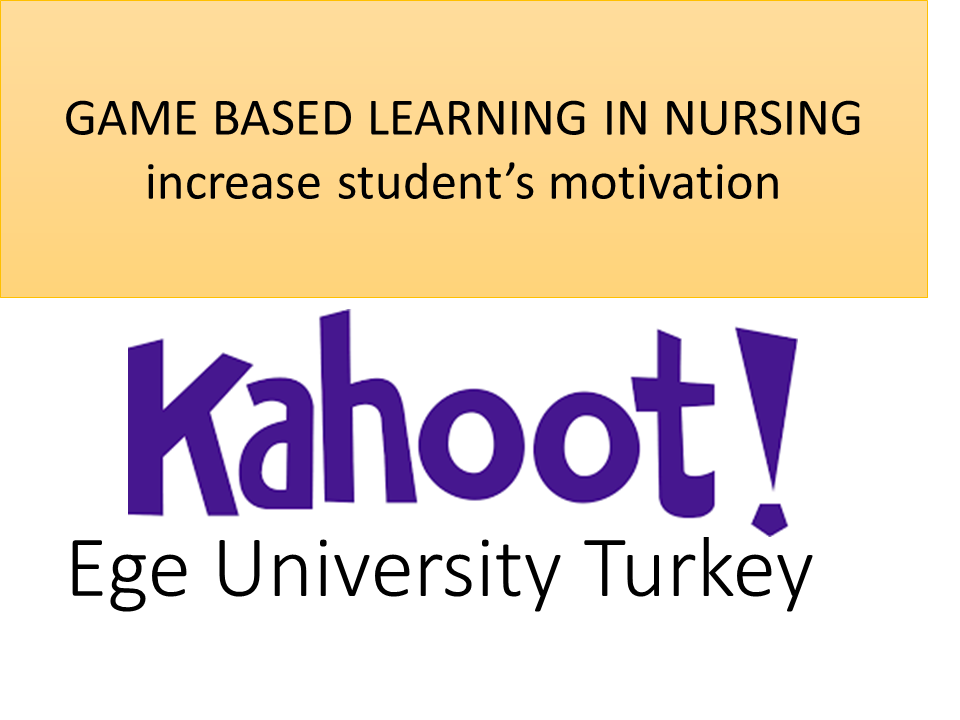The Effect of Game-Based Learning on Motivation and Learning Strategies of Nursing Students in Occupational Health Nursing Course
DOI:
https://doi.org/10.23917/bik.v16i1.1499Keywords:
motivation, learning, game based learning, kahoot, nursing studentAbstract
Aim of this study is to evaluate the effect of game-based learning on the motivation and learning strategies of nursing students. A quasi-experimental research design that was with a pre-post test design without a control group was used in this research. The sample of the study consisted of 74 third grade students. The Sociodemographic Characteristics Question Form and Motivated Strategies for Learning Questionnaire were used for data collection tool. The mean age of nursing students is 21.45±0.62. 85.1% of them are women. A statistically significant difference was found between the pre- and the post-test mean of the nursing students' subscales of control of learning beliefs, intrinsic goal orientation, test anxiety, self-efficacy for learning and performance (p<0.05). There were statistically significant differences between the pre and post-test Learning Strategies Scale subscale scores, nursing students obtained higher mean scores from critical thinking, help seeking, peer learning, metacognitive self-regulation subscales at the post-test (p<0.05). As a result of this study, it was found that Kahoot! has an important influence on the motivation and learning strategies of nursing students. In the development of learning in students' theoretical and practical training, using Kahoot! which is one of the game-based student response systems will be useful.
Downloads
References
Abdullah, K. L., & Chan, C. M. (2018) A systematic review of qualitative studies exploring peer learning experiences of undergraduate nursing students (Tinjauan sistematis studi kualitatif yang mengeksplorasi pengalaman belajar rekan mahasiswa keperawatan sarjana). Nurse education today, 71, 185-192. https://doi.org/10.1016/j.nedt.2018.09.018
Bawa, P. (2019) Using kahoot to inspire. Journal of Educational Technology Systems (Menggunakan kahoot untuk menginspirasi)., 47(3), 373-390. https://doi.org/10.1177/0047239518804173
Bicen, H., & Kocakoyun, S. (2018) Perceptions of students for gamification approach: Kahoot as a case study (Persepsi siswa terhadap pendekatan gamifikasi: Kahoot sebagai studi kasus). International Journal of Emerging Technologies in Learning, 13(2), 22. https://doi.org/10.3991/ijet.v13i02.7467
Bonanomi, A., Olivari, M. G., Mascheroni, E., Gatti, E., & Confalonieri, E. (2018) Us?ng A Mult?d?mens?onal Rash Analys?s To Evaluate The Psychometr?c Propert?es Of The Mot?vated Strateg?es For Learn?ng Quest?onna?re (MSLQ) Among H?gh School Students. Tpm (Menggunakan Analisis Ruam Multidimensi Untuk Mengevaluasi Properti Psikometrik Dari Strategi Termotivasi Untuk Pembelajaran Quest?onna?re (MSLQ) Di Antara Sekolah Menengah Atas Siswa. Tpm: Pengujian, Psikometri, Metodologi dalam Psikologi Terapan, 25(1)). Testing, Psychometrics, Methodology in Applied Psychology, 25(1). https://doi.org/10.4473/TPM25.1.5
Büyüköztürk, ?., Akgün, Ö. E., Kahveci, Ö., & Demirel, F. (2004) Güdülenme ve ö?renme stratejileri ölçe?inin Türkçe formunun geçerlik ve güvenirlik çal??mas?. Kuram ve Uygulamada E?itim Bilimleri, 4(2), 207-239.
Cameron, KE., & Bizo, LA. (2019) Use of the game-based learning platform KAHOOT! to facilitate learner engagement in Animal Science students. Research in Learning Technology (Penggunaan platform pembelajaran berbasis game KAHOOT), 27, 1-14. https://doi.org/10.25304/rlt.v27.2225
Chojecki, P., Lamarre, J., Buck, M., St-Sauveur, I., Eldaoud, N., & Purden, M. (2010) Perceptions of a peer learning approach to pediatric clinical education (Persepsi pendekatan pembelajaran rekan untuk pendidikan klinis pediatrik). International Journal of Nursing Education Scholarship, 7(1). https://doi.org/10.2202/1548-923X.1893
Davidson, S. J., & Candy, L. (2016) Teaching EBP using game?based learning: Improving the student experience. Worldviews on Evidence?Based Nursing (Mengajar EBP menggunakan pembelajaran berbasis game: Meningkatkan pengalaman siswa. Pandangan Dunia tentang Keperawatan Berbasis Bukti), 13(4), 285-293. https://doi.org/10.1111/wvn.12152
Graham, K. (2015) TechMatters: Getting into Kahoot!(s): Exploring a game-based learning system to enhance student learning (Menjelajahi sistem pembelajaran berbasis game untuk meningkatkan pembelajaran siswa). LOEX Quarterly, 42(3), 4.
Hamid, S., & Singaram, V. S. (2016) Motivated strategies for learning and their association with academic performance of a diverse group of 1st-year medical students (Memotivasi strategi untuk belajar dan hubungannya dengan prestasi akademik dari beragam kelompok mahasiswa kedokteran tahun pertama). African Journal of Health Professions Education, 8(1), 104-107. https://doi.org/10.7196/AJHPE.2016.v8i1.757
Hung, H. T. (2017) The integration of a student response system in flipped classrooms (Integrasi sistem respons siswa di kelas terbalik).. Language Learning & Technology, 21(1), 16-27.
Ismail, M. A.-A., & Mohammad, J. A. M. (2017) Kahoot: A promising tool for formative assessment in medical education (Alat penilaian formatif yang menjanjikan dalam pendidikan kedokteran.). Education in Medicine Journal, 9(2), 19–26. https://doi.org/10.21315/eimj2017.9.2.2
Ismail, M. E., Sa'Adan, N., Samsudin, M. A., Hamzah, N., Razali, N., & Mahazir, I. I. (2018) Implementation of the gamification Concept Using KAHOOT! (Implementasi Konsep gamifikasi Menggunakan KAHOOT!). Among TVET Students: An Observation. In Journal of Physics: Conference Series. 1140 (1), 012-013. https://doi.org/10.1088/1742-6596/1140/1/012013
Kahoot!. (2020) Kahoot! for schools. How it works( Bagaimana itu bekerja). 2020 URL:https://kahoot.com/schools/how-it-works/ (Eri?im tarihi:10.11.2020)
Kinder, F. D., & Kurz, J. M. (2018) Gaming strategies in nursing education. Teaching and Learning in Nursing (Strategi permainan dalam pendidikan keperawatan. Mengajar dan Belajar di Keperawatan)., 13(4), 212-214. https://doi.org/10.1016/j.teln.2018.05.001
Martin, AJ. (2008) Enhancing student motivation and engagement: the effects of a multidimensional intervention (Meningkatkan motivasi dan keterlibatan siswa: efek dari intervensi multidimensi). Contemporary Educational Psychology, 33(2), 239–269. https://doi.org/10.1016/j.cedpsych.2006.11.003
Muhridza, N. H. M., Rosli, N. A. M., Sirri, A., & Samad, A. A. (2018) Using game-based technology, KAHOOT! for classroom engagement (Menggunakan teknologi berbasis game, KAHOOT! untuk keterlibatan kelas). LSP International Journal, 5(2). https://doi.org/10.11113/lspi.v5n2.77
Nadeem, N. H., & Al Falig, H. A. (2020) Kahoot! Quizzes: A Formative Assessment Tool to Promote Students’ Self-Regulated Learning Skills (Kuis: Alat Penilaian Formatif untuk Mempromosikan Keterampilan Belajar Mandiri Siswa). Journal of Applied Linguistics and Language Research, 7(4), 1-20.
Özaras-Öz, G. Ö., & Ordu, Y. (2021). The effects of web based education and Kahoot usage in evaluation of the knowledge and skills regarding intramuscular injection among nursing students(Pengaruh pendidikan berbasis web dan penggunaan Kahoot dalam evaluasi pengetahuan dan keterampilan mengenai injeksi intramuskular di kalangan mahasiswa keperawatan). Nurse Education Today, 103, 104910. https://doi.org/10.1016/j.nedt.2021.104910
Pintrich, P. R., Smith, D. A. F., Garcia, T., & McKeachie, W. J. (1991) A manual for the use of the Motivated Strategies for Learning Questionnaire (MSLQ) Ann Arbor. MI: National Center for Research to Improve Postsecondary Teaching and Learning, 1-76 ((Manual untuk penggunaan Motivated Strategies for Learning Questionnaire (MSLQ) Ann Arbor. MI: Pusat Penelitian Nasional untuk Meningkatkan Pengajaran dan Pembelajaran Pascasarjana, 1-76.)
Pintrich, PR, & Schrauben, B. (1992) Students’ motivational beliefs and their cognitive engagement in classroom academic tasks (Keyakinan motivasi siswa dan keterlibatan kognitif mereka dalam tugas akademik kelas). Student Perceptions in the Classroom, 7, 149–183
Plump, CM, & LaRosa, J. (2017) Using Kahoot! in the classroom to create engagement and active learning: a gamebased technology solution for eLearning novices (Menggunakan Kahoot! di kelas untuk menciptakan keterlibatan dan pembelajaran aktif: solusi teknologi berbasis game untuk pemula eLearning). Management Teaching Review, 2(2), 151–158. http://doi.org/10.1177/2379298116689783
Ravanipour, M., Bahreini, M., & Ravanipour, M. (2015) Exploring nursing students’ experience of peer learning in clinical practice (Menjelajahi pengalaman mahasiswa keperawatan tentang pembelajaran rekan dalam praktik klinis). Journal of education and health promotion, 4. http://doi.org/10.4103/2277-9531.157233.
Sarkar, N., Ford, W., & Manzo, C. (2017) Engaging digital natives through social learning (Melibatkan penduduk asli digital melalui pembelajaran sosial). Systemics, Cybernetics and Informatics, 15(2), 1-4.
Tan Ai Lin, D., Ganapathy, M., & Kaur, M. (2018) Kahoot! It: Gamification in Higher Education (Kahoot! Itu: Gamifikasi di Pendidikan Tinggi). Pertanika Journal of Social Sciences & Humanities, 26(1).
Tewthanom, K. (2019) The Effect of Kahoot Web-Based Learning on Learning Skills of Pharmacy Students The Trend in Clinical Pharmacokinetics Course for 2 Generations (Pengaruh Pembelajaran Kahoot Berbasis Web terhadap Keterampilan Belajar Mahasiswa Farmasi: Tren Kursus Farmakokinetik Klinik Selama 2 Generasi). Indian Journal of Pharmaceutical Education and Research, 53(2), 212-215. http://doi.org/10.5530/ijper.53.2.28
Wang, A. I., & Lieberoth, A. (2016) The effect of points and audio on concentration, engagement, enjoyment, learning, motivation, and classroom dynamics using Kahoot (Pengaruh poin dan audio terhadap konsentrasi, keterlibatan, kesenangan, pembelajaran, motivasi, dan dinamika kelas menggunakan Kahoot). In T. Connolly & L. Boyle (Eds.), Proceedings of the 10th European conference on games based learning, reading (pp. 737–748). Reading, UK.
Wang, A., Zhu, M. and Saetre, R. (2016) The Effect of Digitizing and Gamifying Quizzing in Classrooms. Norwegian University of Science and Technology (Pengaruh Kuis Digitalisasi dan Gamifikasi di Ruang Kelas.), Trondheim, Norway
Wang, AI. (2015) The wear out effect of a game-based student response system ((Efek aus dari sistem respon siswa berbasis permainan.). Computers & Education, 82, 217–227. https://doi.org/10.1016/j.compedu.2014.11.004
Whitton, N. (2011) Game engagement theory and adult learning, Simulation & Gaming (Teori keterlibatan permainan dan pembelajaran orang dewasa, Simulasi & Permainan: Jurnal Interdisipliner). : An Interdisciplinary Journal, 42,5,596–609. https://doi.org/10.1177/1046878110378587
Wichadee, S., & Pattanapichet, F. (2018) Enhancement of performance and motivation through application of digital games in an English language class (Peningkatan kinerja dan motivasi melalui penerapan permainan digital di kelas bahasa Inggris). Teaching English with Technology, 18(1), 77-92.

Downloads
Submitted
Accepted
Published
How to Cite
Issue
Section
License
Copyright (c) 2023 Sevcan Topçu

This work is licensed under a Creative Commons Attribution 4.0 International License.


















